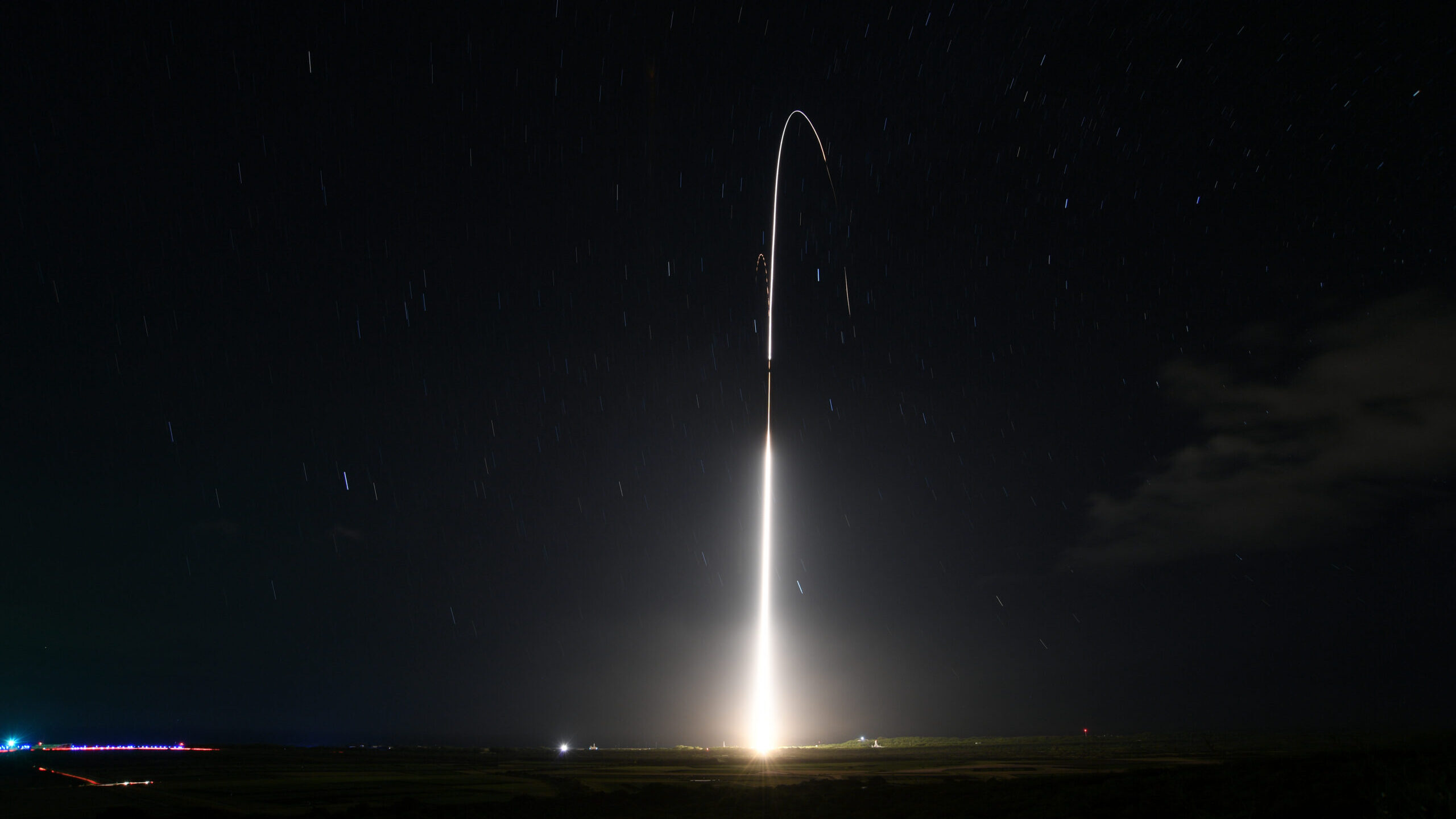
The Missile Defense Agency (MDA) and U.S. Navy sailors manning the Aegis Ashore Missile Defense Test Complex (AAMDTC) at the Pacific Missile Range Facility (PMRF) at Kauai, Hawaii, successfully conducted Flight Test Integrated-03 (FTI-03). (Ryan Keith/Missile Defense Agency)
WASHINGTON: The Missile Defense Agency announced today a successful flight test that demonstrated further integration of the Terminal High Altitude Area Defense and the PAC-3 Missile Segment Enhancement, just one day after the agency released its $9.6 billion fiscal 2023 budget request.
The THAAD weapons system fired two PAC-3 Missile Segment Enhanced interceptors at a Black Dagger target during the test, conducted this morning at White Sands Missile Range, NM. A MDA press release said preliminary results indicated the objectives were “achieved.”
“The success of today’s flight test marks a critical milestone for the integration of the THAAD and Patriot weapon systems,” MDA Director Vice Adm. Jon Hill said in the announcement. “The integration of the PAC-3 MSE interceptor into the THAAD weapon system provides the combatant commands and soldiers on the ground the capability to use the right missile for the right threat at the right time.”
As part of its budget request, the agency is seeking $422 million for the THAAD program, including procurement funds for three interceptors and the delivery of 85 interceptors. The service’s five-year layout for THAAD interceptors shows the the agency starts to ramp-up, with the procurement of 125 interceptors over the FYDP.
Overall, the agency’s request is down roughly $736 million from the $10.3 billion lawmakers handed the agency in the FY22 appropriations bill passed earlier this month. MDA plans to spend roughly $7.9 billion on research, development, test and evaluation — about 82 percent of its overall spending, up $645 million over the FY22 enacted spending.
“What we’re focused on today is dealing with a very formidable and evolving threat,” Hill said during Monday’s budget rollout. “And so every penny that we’re spending in the ’23 budget is focused on how we deal with those threats across a multiple set of interesting scenarios.”
The request includes about $1.2 billion in procurement for FY23, down from the $2.6 billion that Congress appropriated for fiscal 2022. The agency’s five-year layout shows that the agency’s procurement spending will continue to rise by hundreds of millions per year over the future years defense program, or FYDP. The service plans to spending $1.42 billion next year and in FY27 will spend $2.26 billion on procurement.
MDA is requesting $539 million for its Defense of Guam portfolio, including the continuing design and development of several land-based radar systems, the purchase of weapon systems components and military construction activities. The MDA’s Defense of Guam portfolio is part of a broader $892 million the Pentagon plans to spend on Guam defense, according to DoD overview slides.
RELATED: Aegis Ashore Too Limited For Guam: Former INDO-PACOM Head
Hill told reporters at the briefing Monday that the Defense of Guam architecture will be a mix of Army and Navy systems and not an Aegis Ashore. That would include Aegis ships, SM-3 and SM-6 missiles and the Army Integrated Battle Command System.
“Think of it as a distributed system, because we’re going to respond to the number one requirement of 360-degree coverage against ballistic, cruise and hypersonic threats,” Hill said.
The Aegis Missile Defense System would be funded at $1.6 billion in the request, procuring 47 SM-3 Block IB missiles and 10 SM-3 Block IIA missiles. It also provides upgrades to sensors on the Navy’s older ships and includes the development of “radar sensitivity” upgrades for the Navy’s newest destroyers.
Slides from MDA’s briefing show that it plans to spend $225 million on hypersonic missile defense, including the development of the service’s Glide Phase Interceptor, intended to intercept hypersonic missiles during the glide phase of flight. In November, MDA announced that Lockheed Martin, Northrop Grumman, and Raytheon had been chosen under other transaction authorities, but Hill noted at the briefing that he didn’t have specifics for the program’s timeline.
“We’re evaluating those proposals now. So I’m not ready to say, you know, what the end state will look like or what that end game will look like,” Hill said. “We know we can move quickly, we know the propulsion capability to get there. It’s just operating in different environments so it’s all about the front end. And so we have to do more work. We’re not even at a system requirements review yet.”
Dee Dee Martinez, comptroller of the Missile Defense Agency, said that the MDA is asking Congress for $89 million for its Hypersonic and Ballistic Tracking Space Sensor (HBTSS). That ask includes funding for two HBTSS satellites and on-orbit experimentation.
The request also includes $2.8 billion for its Ground-based Midcourse Defense, which MDA slides note sustain and improve “performance, reliability, availability, and cybersecurity resiliency.” The GMD funding includes includes money for the Next-Generation Interceptor, though the presentation didn’t specify how much. However, Martinez said that the the request “continues” funding for two industry teams, Lockheed Martin and Northrop Grumman, through critical design review.
“This plan reduces technical risk in meeting common requirements and advanced threats, secures competitive production pricing and creates incentives for early delivery to the warfighter, which is one of their top priorities,” Martinez said.






















